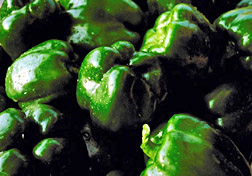This page has been archived and is being provided for reference purposes only. The page is no longer being updated, and therefore, links on the page may be invalid.
|
|
Beneficial Bacteria Help Control Produce Pathogen
By Laura McGinnisJune 2, 2008
A new food safety treatment developed by the Agricultural Research Service (ARS) could increase the effectiveness of conventional produce sanitization methods.
ARS microbiologist Ching-Hsing Liao developed and tested the method, which pits beneficial bacteria against potentially harmful ones. The beneficial bacteria inhibit the growth of pathogens that survive initial physical or chemical attempts to remove them from fresh produce. Produce pathogens are a prominent source of food-borne illness in the United States.
At the ARS Eastern Regional Research Center (ERRC) in Wyndmoor, Pa., Liao identified three beneficial bacterial antagonists for use in food safety intervention. He dipped bell peppers in solutions of water containing the beneficial antagonists and examined the effect on surface pathogens such as Salmonella and E. coli O157:H7.
One bacterium, known as Pseudomonas fluorescens 2-79, was particularly effective. Dipping peppers in a Pf 2-79 solution for about two minutes halted pathogen multiplication almost entirely.
On untreated peppers, pathogen populations multiplied about 100,000 times when stored at 68 degrees Fahrenheit for two days. But treating peppers with Pf 2-79 suppressed pathogen growth. This treatment could potentially prevent pathogens from proliferating to numbers capable of causing human illness.
The dip also stopped the growth of two common spoilage bacteria and reduced the development of soft rot.
Pf 2-79 is easy to grow and can colonize several types of produce. Because it can grow at refrigeration temperatures, it could be an effective control agent for cold-tolerant pathogens such as Listeria monocytogenes and Yersinia enterocolitica.
Liao and his colleagues plan to validate the research on a larger scale. Their research will also aim to identify additional bacterial strains that could be used with Pf 2-79 to further improve produce safety and quality.
Consumers can help remove pathogens from produce at home by taking simple food safety precautions, such as peeling, washing or cooking the produce.
ARS is the U.S. Department of Agriculture's chief scientific research agency.

